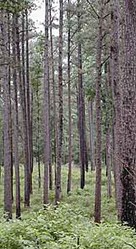Even when food is available, it must be the right kind of food to meet the nutrition demands of wildlife. For example, a pine forest with lots of sweetgum trees at ground level may look "green" and healthy (see photos), but deer don't like to eat sweetgum! Thus, it's easy to see the importance of managing habitats to provide year-round, high-quality forage.
Water
Water is required by wildlife for digestion, maintaining body temperature, and other life processes. Adequate amounts of freestanding water (springs, creeks, farm ponds, lakes, etc.) are generally not a concern for most of Mississippi's wildlife because of our abundant rainfall, and some animals can even get all of their water needs from eating succulent green plants and dew on leaves.
Cover
Cover is a habitat's ability to provide the protection that animals need to survive. It shelters animals from bad weather conditions and conceals them from predators while they eat, sleep, and care for their young. Cover needs are different for each species; for example, bobwhite quail require grasses and forbs at ground level to protect them from avian predators while they forage, whereas a raccoon can live practically anywhere, including cities and garbage dumps!
In order for wildlife to thrive, each habitat resource must be available within the area used by that species. Unfortunately, a forest doesn't always provide the right amounts of the needed habitat resources on its own to support the number of animals that we want them to.
Habitat Management in Action
For instance, I recently worked with a hunting club located in the pine belt of Mississippi that is devoted to turkey hunting. We know that turkeys require a somewhat open layer of grasses and forbs along the ground in which their poults can safely forage for high-protein insects and plants. However, their pine forest was too thick with undesirable hardwood trees (like sweetgum), so the desired plant communities could not develop. Thus, they needed to apply habitat management practices such as selective herbicides, prescribed fire, creating wildlife openings, and fertilizing native vegetation to create the right conditions for turkeys to thrive.


